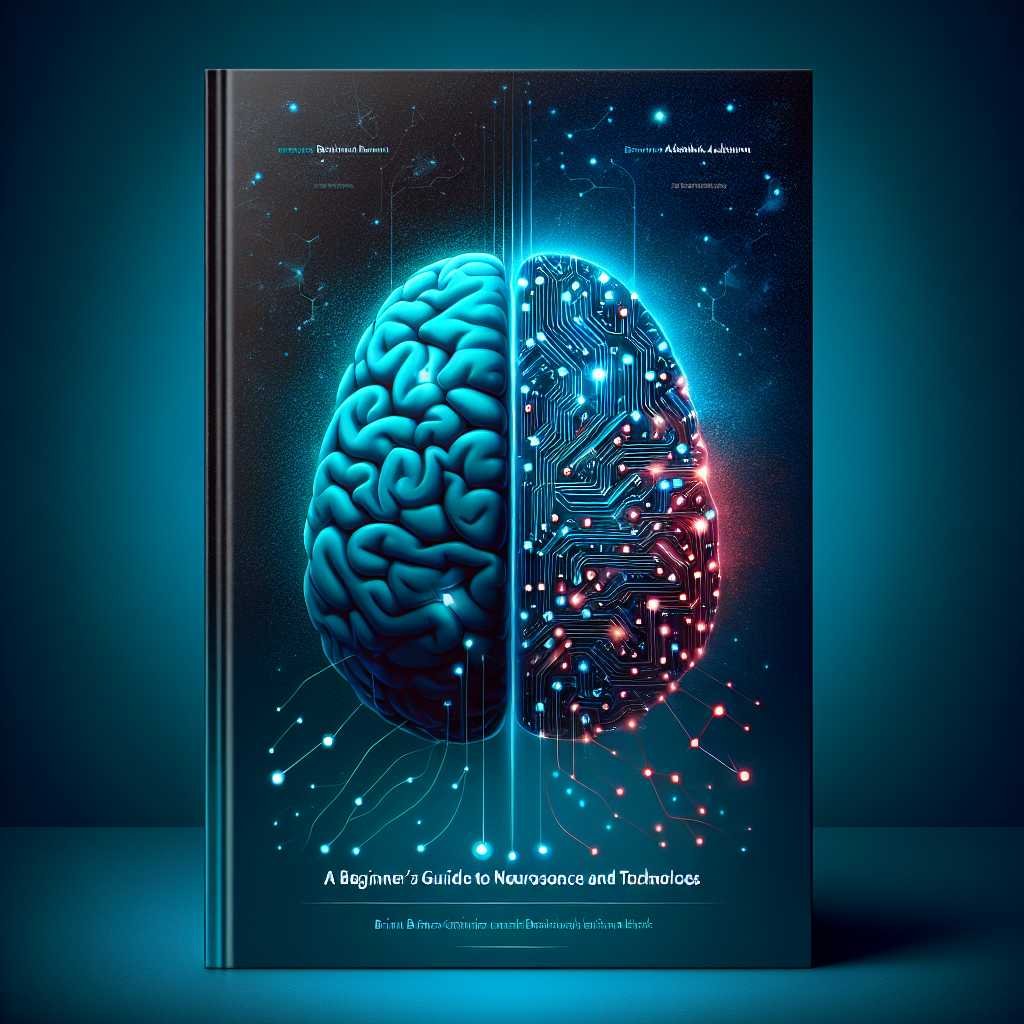Beginner’s Guide to the Brain and Brain‑Computer Interfaces (BCIs): Inside Akanksha Acharya’s Accessible Paperback
If you’ve ever wondered how thoughts become actions—or how computers could one day read brain signals—this book is your on‑ramp. Brain and Brain-Computer Interfaces: A Beginner’s Guide to Neuroscience and Technology by Akanksha Acharya promises exactly what curious readers crave: clear, engaging explanations that make neuroscience feel less like rocket science and more like a fascinating story about you.
Think of it as a friendly lab guide. You’ll learn what neurons do, how brain waves get recorded, and how machines can decode those signals into something meaningful. And you’ll do it without drowning in jargon. The chapters include learning objectives, review questions, and fun facts that keep you moving and reinforce what you’ve just learned. If you’re a student, a career switcher, or a hobbyist who’s seen BCIs in the news and wants a solid foundation, this is a smart place to start.
What This Book Covers—and Why It Works for Beginners
What makes a great beginner book? Structure, not just information. Acharya’s approach encourages deliberate learning: each chapter sets clear objectives, offers bite‑sized explanations, and ends with questions to lock in comprehension. That rhythm is exactly what makes complex ideas stick. You don’t just read; you practice understanding.
Content-wise, you can expect the essentials: – Brain anatomy basics: cortex, lobes, and what they do. – Neurons and synapses: how signals fire and travel. – Recording methods: EEG, fMRI, and why noninvasive options matter. – Intro to BCIs: converting neural activity into machine‑readable signals. – Ethical considerations: privacy, consent, and long‑term effects. – Real-world examples: communication aids, rehabilitation use cases, and research directions.
Curious to see the format for yourself? View on Amazon.
Here’s why that matters: when you’re new to neuroscience, you don’t need a 600‑page textbook or dense math on day one. You need conceptual clarity and motivation boosters. Learning objectives help you track progress. Review questions build retrieval practice, a proven technique for memory. And fun facts spark curiosity, which is the fuel that keeps you reading.
Brain Basics, Explained Simply
Let’s start with neurons—your brain’s messengers. Each neuron passes tiny electrical signals down a long tail called an axon, then hands off the message through chemical messengers (neurotransmitters) at the synapse. That chain reaction is how you think, move, feel, and remember. A helpful image: think of a stadium wave. One person stands, then the next, and so on—not because each person jumps at once, but because the signal travels in order.
If you want a reliable primer on the brain’s big picture, the NIH’s Brain Basics is a short, trustworthy read: NIH Brain Basics.
Neuroscience uses several tools to measure what neurons are doing: – EEG (electroencephalography) sits on your scalp and picks up brain waves. It’s safe, noninvasive, and relatively affordable. – fMRI shows which brain areas are using more oxygen—handy for mapping function, but slower than electrical measurements. – MEG detects tiny magnetic fields from brain activity with high temporal precision; it’s powerful but costly.
Each tool has trade‑offs. EEG is fast and portable, but it’s noisy and less precise in location. fMRI has great spatial detail but poor timing resolution. Learning these trade‑offs helps you understand why most beginner-friendly BCIs use EEG.
What Is a Brain–Computer Interface?
A brain–computer interface translates neural activity into commands to control something outside your body—like a cursor, a keyboard, or a robotic arm. BCIs come in several flavors: – Noninvasive: EEG caps or headbands that read scalp signals. – Semi-invasive: electrodes sit on the brain’s surface (ECoG), often in clinical contexts. – Invasive: electrodes go into brain tissue, offering higher signal fidelity but with surgical risks.
Why is it thrilling? Because BCIs create new communication pathways. People with paralysis can type or move a robotic limb. Stroke survivors can regain function through neurofeedback. Researchers are exploring cognitive monitoring for fatigue and attention. The medical and ethical implications are huge, which is why the technology is regulated and studied carefully. For a solid overview of current devices and policy considerations, see the FDA’s overview of BCIs: FDA on Brain–Computer Interface Devices.
BCIs rely on signal processing and machine learning. Here’s the simplified pipeline: 1. Acquire a signal (e.g., EEG). 2. Filter out noise (eye blinks, muscle movement). 3. Extract features (frequency bands like alpha, beta). 4. Classify (translate patterns into actions). You don’t need to be a data scientist to appreciate the flow, but the book’s digestible explanations will help you recognize what each step does—and why it’s necessary.
Want to try it yourself and keep a copy on your desk? Buy on Amazon.
For a research‑grade deep dive, this review provides context on clinical applications and progress: Nature Reviews Neurology on BCIs.
How the Book Teaches Complex Tech Without Overwhelm
Clarity beats cleverness. This guide uses plain language and builds concepts from the ground up. You’ll encounter analogies for noisy EEG signals, examples that connect brain rhythms to states (like relaxed alpha waves), and short recaps so you never feel lost. When chapters end with review questions, don’t skip them—they are the bridge between passive reading and active learning.
Another plus: you’ll see ethical notes woven throughout. Consent, data privacy, and the potential misuse of neural data aren’t footnotes; they’re core to understanding BCIs responsibly. That broader framing ensures you’re not just learning how BCIs work, but why responsible design matters.
A Realistic Learning Path, From Curiosity to Your First Project
If you’re wondering how to turn this book into a skill, try this path: – Week 1: Learn brain structure and neuron basics. Sketch a simple diagram after reading. – Week 2: Study EEG fundamentals and the meaning of alpha, beta, theta bands. – Week 3: Watch a free instruction video on artifact removal and signal processing (e.g., filter basics). – Week 4: Try a simple open dataset (many universities share EEG files) and plot a power spectrum using Python. – Week 5: Read case studies in the book on spellers or neurofeedback; write a one‑page summary of what worked and why. – Week 6: Design a tiny experiment, like measuring your relaxed vs. focused state with consumer gear; document what you observe and what might be noise.
That progression keeps scope small but momentum strong. You’ll avoid the common trap of downloading advanced BCI code before you understand the signals themselves. Ready to start learning today? See price on Amazon.
If you’re curious about national research priorities, the BRAIN Initiative offers a clear window into where the field is headed: NIH BRAIN Initiative.
Who This Book Is For
- High school and early college students who want a friendly primer.
- Educators looking for an accessible classroom companion with built‑in questions and objectives.
- Career switchers from software, psychology, or bioengineering seeking a conceptual landing pad.
- Hobbyists who’ve tried consumer EEG devices and want to understand the science behind the signal.
If you already have graduate-level neurophysiology or machine learning, you’ll still find this a helpful refresher and teaching resource—but it’s designed first for beginners.
Buying Guide: Paperback Reading Experience and How to Choose a Beginner BCI Book
When you’re picking a beginner guide in neuroscience and BCIs, look for: – Chapter learning objectives and summaries (so you can skim and still retain). – Review questions (to reinforce key concepts). – Clear illustrations with captions (signals, electrodes, brain areas). – A glossary (to demystify recurring terms like “artifact,” “feature extraction,” “classifier”). – Ethical coverage (privacy, consent, long‑term safety). – References to reputable sources (peer‑reviewed journals, FDA, NIH).
Paperback vs. digital? A paperback can be easier to annotate, flip between figures, and review quickly. For many learners, physically marking key pages boosts recall. If you’re buying for a classroom or study group, confirm that the book’s layout and headings make it easy to assign sections and create lesson plans.
Comparing beginner-friendly options and want the details? Check it on Amazon.
As you compare titles, scan the table of contents and a random chapter. Can you explain one page in your own words after reading it? If yes, you’ve found the right level. If not, it might be either too shallow or too advanced.
How This Book Compares to Other Intros
- Popular neuroscience books (think narrative nonfiction) inspire wonder but often skip the “how.” They’re great for curiosity, less ideal for starting projects.
- Technical textbooks provide depth but assume a lot of math and prior knowledge. They can be excellent next steps once you’ve built a base.
- Maker‑oriented guides focus on hardware and code, sometimes at the expense of foundational brain science.
This book sits in a sweet spot: factual and structured, but approachable. It’s not a replacement for a comprehensive textbook or a signal processing manual; it’s your foundation. Once you master these chapters, you can step confidently into more advanced courses or toolkits.
Support our work by shopping here: Shop on Amazon.
Common Pitfalls Beginners Face (and How This Book Helps)
- Jumping straight to code without understanding signals: The book emphasizes signal basics first, saving you hours of confusion later.
- Confusing correlation with causation: You’ll learn why brain activity aligns with tasks but doesn’t always “cause” behavior in simple ways.
- Underestimating noise: Eye blinks, jaw clenches, and poor electrode contact can swamp your data. The book flags those artifacts so you know what to expect.
- Ignoring ethics and consent: You’ll see why data privacy and clear consent aren’t “nice to have”—they’re foundational to trust and adoption.
- Expecting mind‑reading: BCIs recognize patterns, not thoughts. Managing expectations keeps learning motivating and realistic.
Ethics and Safety: Questions You Should Ask
BCIs can change lives, but they also raise thoughtful questions. Who owns your brain data? How do we prevent misuse? What happens if a device misclassifies signals? These aren’t abstract concerns—they shape policy and practice. The World Health Organization has called for robust oversight and safeguards in neurotechnology, focused on autonomy, privacy, and equity: WHO guidance on neurotechnology ethics. As the field grows, so does the need for transparency and patient‑centered design.
For ongoing developments and cross‑disciplinary insights, IEEE Spectrum’s coverage offers accessible reporting on the technology’s progress and pitfalls: IEEE Spectrum on Brain–Computer Interfaces.
Getting Hands‑On: Safe, Simple Ways to Explore
You don’t need a lab to satisfy your curiosity: – Learn the EEG alphabet: alpha, beta, theta—what they correlate with and how we measure them. – Review open EEG datasets and run simple visualizations in Python or MATLAB. – Try guided breathing and note changes in alpha power in demos or tutorials. – Follow university lectures that explain artifact removal (e.g., independent component analysis) at a conceptual level before running any code.
Many consumer EEG headbands offer basic biofeedback experiences. While they’re not clinical instruments, they can spark useful questions and help you connect theory to real signals. The key is to approach them as learning tools, not diagnostic devices.
Want to skim a few pages before you commit and see if the tone clicks with you? View on Amazon.
What You’ll Walk Away With
- A mental map of how the brain communicates and how we can record its signals.
- A plain‑English understanding of what BCIs do (and don’t do).
- Confidence to read research intros and news stories without getting lost.
- A realistic path to your first small project or classroom plan.
- An ethical compass to evaluate hype and prioritize safety and privacy.
If you’re a teacher, you’ll also find ready‑to‑use prompts in the review questions. If you’re a student or self‑learner, those questions become your study guide.
FAQ: Brain and BCI Basics, Answered
Q: What is a brain–computer interface in simple terms?
A: A BCI is a system that reads patterns in your brain activity and translates them into commands to control external devices, like typing a letter or moving a cursor—often using noninvasive sensors like EEG.
Q: Do I need advanced math to start learning about BCIs?
A: Not to start. You can grasp the concepts—signals, features, classifiers—without heavy math. As you build toward projects, some statistics and linear algebra will help, but they’re not prerequisites for understanding the basics.
Q: Is this book suitable for high school students?
A: Yes, if they’re motivated and comfortable with science. The chapters’ learning objectives and review questions make it a solid fit for advanced high schoolers, early undergraduates, and curious adults.
Q: What are real‑world uses of BCIs today?
A: Communication aids for people with paralysis, neurorehabilitation after stroke, and research systems for controlling cursors or robotic devices. Clinical applications are growing, and regulation supports safety and evidence.
Q: Are BCIs safe?
A: Noninvasive systems like EEG are very safe when used as directed. Invasive systems involve surgical risk and require medical oversight. Always consult reliable sources and, for medical devices, follow regulatory guidance.
Q: Can BCIs read thoughts?
A: No. They detect patterns that correlate with states or intentions, not detailed thoughts. Even advanced systems infer limited, task‑specific information.
Q: Where can I learn more about the science?
A: For accessible overviews, try NIH Brain Basics and the FDA’s BCI page, then branch into peer‑reviewed reviews like Nature Reviews Neurology on BCIs.
Final Takeaway
Brain and Brain-Computer Interfaces: A Beginner’s Guide to Neuroscience and Technology succeeds because it respects your curiosity and your time. It delivers clarity without shortcuts, builds confidence through structured learning, and invites you to ask the big ethical questions that come with powerful tech. If you’re ready to turn curiosity into understanding—and understanding into action—this is an excellent first step. Keep exploring, keep questioning, and if you enjoyed this guide, consider subscribing for more insights on neuroscience, AI, and human‑computer interaction.
Discover more at InnoVirtuoso.com
I would love some feedback on my writing so if you have any, please don’t hesitate to leave a comment around here or in any platforms that is convenient for you.
For more on tech and other topics, explore InnoVirtuoso.com anytime. Subscribe to my newsletter and join our growing community—we’ll create something magical together. I promise, it’ll never be boring!
Stay updated with the latest news—subscribe to our newsletter today!
Thank you all—wishing you an amazing day ahead!
Read more related Articles at InnoVirtuoso
- How to Completely Turn Off Google AI on Your Android Phone
- The Best AI Jokes of the Month: February Edition
- Introducing SpoofDPI: Bypassing Deep Packet Inspection
- Getting Started with shadps4: Your Guide to the PlayStation 4 Emulator
- Sophos Pricing in 2025: A Guide to Intercept X Endpoint Protection
- The Essential Requirements for Augmented Reality: A Comprehensive Guide
- Harvard: A Legacy of Achievements and a Path Towards the Future
- Unlocking the Secrets of Prompt Engineering: 5 Must-Read Books That Will Revolutionize You







